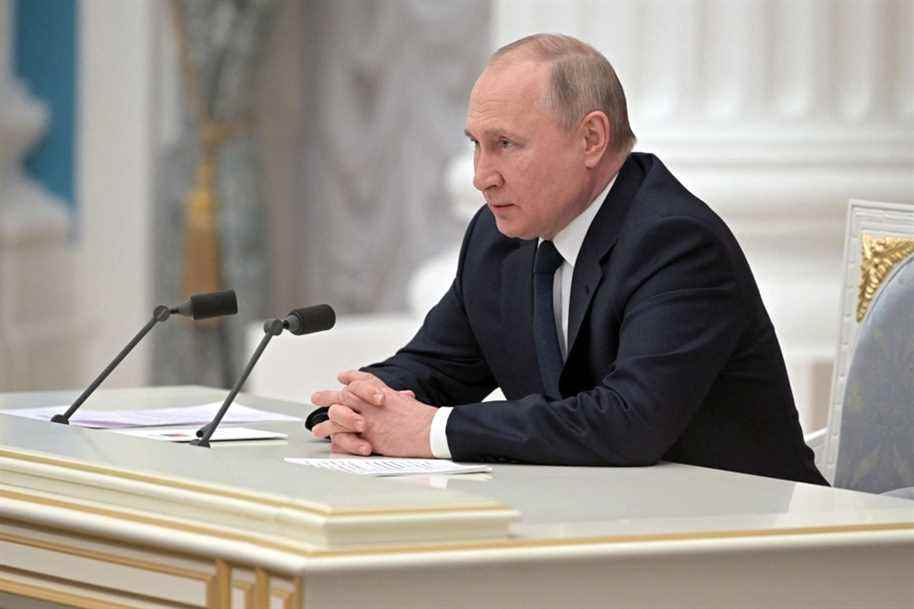By recognizing the independence of the self-proclaimed republics of Donetsk and Lugansk, in the Donbass region in eastern Ukraine, on February 21, Vladimir Putin put an end to the negotiated resolution of a secessionist conflict that had been active for 2014. Many experts then anticipated as a last resort a Russian invasion limited to these two provinces, as was the case in Abkhazia and South Ossetia during the Russo-Georgian war in 2008. However, two days later, the Russian president went to war against all of Ukraine, taking many observers by surprise, despite warnings to that effect from the Americans.
Posted at 1:00 p.m.
The Kremlin therefore wishes to exercise complete control over its neighbour, which it considers to be an integral part of “Greater Russia”, but also as a buffer zone between Russia and the West. Ukraine is thus the centerpiece in the reconfiguration of the security architecture in Europe desired by Putin, and the war he has just unleashed is the latest in a series of attempts to bring Kiev to heel.
The failure of plan A
Until 2014, Moscow was able to influence Ukraine to a good extent as the population was more or less balanced between pro-Europe and pro-Russia views. A pro-Russian president, Viktor Yanukovych, was also in charge in Kyiv between 2010 and 2014. The Kremlin’s interests were, however, compromised by the Euromaidan protests, which brought a clearly pro-European president and program to power.
The Russian response was to immediately annex Crimea and support pro-Russian separatists in Donetsk and Lugansk. However, these hostile gestures did not deter the new authorities in Kiev from signing association agreements with the European Union. Far from bringing Ukraine back into the Russian fold, they have had the effect of strengthening pro-European and anti-Russian opinion among Ukrainians.
If, in the 2000s, support for joining the North Atlantic Treaty Organization (NATO) was around 20%, today it has reached 60% (Crimea and self-proclaimed republics excluded). Between 2019 and 2021, support for NATO has doubled in the traditionally more reluctant southeastern regions, and NATO and European Union (EU) membership is now enshrined in Ukraine’s Constitution. To question it now would be political suicide.
The failure of plan B
Concretely, destabilizing Ukraine by supporting pro-Russian separatists was aimed at preventing it from joining NATO and the EU, as these organizations refrain from welcoming new members struggling with territorial disputes. As long as the conflict lasted in the east of the country, NATO and the EU would remain out of reach for Kyiv.
This enterprise of destabilization was also intended (as in the case of Transnistria, in neighboring Moldova) to force Kiev to carry out the preferred scenario of the Kremlin: to reintegrate the separatist regions within Ukraine as autonomous territories with a special status, which would have given them a right of veto over Ukraine’s geopolitical orientation.
The Minsk agreements signed in 2015 and supposed to offer a diplomatic solution to this conflict went in this direction, according to Moscow. The problem is that the interpretation of each of the 13 points they contain and the sequence of their execution have always been disputed on both sides. For many Ukrainians, the Minsk agreements lack legitimacy, because Russia is included as a mediator while its active participation alongside the separatists is now well documented.
At the beginning of 2020, even in the Donbass, the majority of the population living in the vast Kiev-controlled portion wanted a return to Ukraine and showed themselves to be less and less inclined to compromise.1
The failure of Plan C
At this point, Ukraine was escaping Moscow more than ever. Always with the aim of keeping the “Western threat” away from what it considers to be its area of influence, Russia then massed a hundred thousand soldiers on the border with Ukraine before announcing its demands: withdrawal of NATO troops from Eastern Europe, NATO’s commitment to end its eastward enlargement, etc. Thinking he was taking advantage of a moment of weakness among the Western allies (chaotic withdrawal of the United States from Afghanistan, electoral campaign in France, scandals around the British Prime Minister, new coalition in power in Germany), Putin hoped that they lower their flag and accede to its demands. Missed.
What Plan D?
Unable to force Ukraine to fall into its orbit and push the Western allies out of its “zone of influence”, Vladimir Putin is now playing his all. Exit negotiation, nuisance and tactical advances. Forcibly overthrowing the “nationalist-fascist” Western “puppet” government in Kiev is the new goal, despite the fact that the war is sending shock waves through Russia itself. Because the majority of Russians, for whom the Ukrainians are by no means enemies, oppose it.
1. Gerard Toal, Gwendolyn Sasse, John O’Loughlin, Kristin M. Bakke, “A new survey of the Ukraine-Russia conflict finds deeply divided views in the contested Donbas region”, washington postFebruary 12, 2021
Closer than you think
Canada is not dependent on Russia, nor its gas, nor its trade. The sanctions will not affect its economy at the same level as in Europe. But the Russian-Ukrainian war affects many of the 1.3 million Canadian citizens who identify as Ukrainian and whose family is in Ukraine. Since Canada is a member of NATO, the Canadian armed forces are notably deployed in Latvia, which borders Russia.
For further
Magdalena Dembinska, The making of de facto States. Neither war nor peaceUniversity of Montreal Press, 2021
Alexandra Goujon, Ukraine, from independence to warThe Blue Rider, 2021
Marlene Laruelle and Jean Radvanyi, Russia, between fears and challengesParis, Armand Colin, 2016

